Introduction
Within This Page
Every part of a building is subject to the effects of outside forces—gravity, wind, earthquakes, and temperature changes, to name a few. Throughout history, people have constructed buildings that have withstood these forces over a long period of time, primarily using rules of thumb derived from their own experiences and those of their predecessors. In recent centuries, the scientific and industrial revolutions introduced analytical approaches that allowed designers to go beyond empirical limitations and predict the behavior of building systems and components that existed only in their imaginations. This gave rise to the formalization and specialization of the modern engineering profession, which in turn led to more accurate and cost-effective designs. Today the individual responsible for ensuring that buildings will remain standing while carrying out their intended functions is the structural engineer.
Description
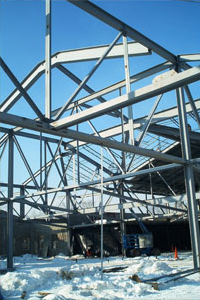
Structural steel framing during erection Photo Credit: Burns & McDonnell
The Council of American Structural Engineers (CASE) defines a structural engineer as: "An engineer with specialized knowledge, training, and experience in the sciences and mathematics relating to analyzing and designing force-resisting systems for buildings and other structures." A structural engineer usually has one of two roles on a building project, as identified by CASE:
- The Structural Engineer of Record (SER) "perform[s] or supervise[s] the analysis, design, and document preparation for the building structure and has knowledge of the requirements for the load carrying structural system." The SER is responsible for the design of the primary structural system, which is "the completed combination of elements which serve to support the building's self-weight, the applicable live load which is based upon the occupancy and use of the spaces, [and] the environmental loads such as wind, seismic, and thermal."
- A Specialty Structural Engineer (SSE) "performs structural engineering functions necessary for the structure to be completed and who has shown experience and/or training in the specific specialty." The SSE "is usually retained by a supplier or subcontractor who is responsible for the design, fabrication, and (sometimes) installation of engineered elements or by the general contractor or subcontractor(s) responsible for construction related services." Common examples of such elements are precast or tilt-up concrete, open web steel joists, pre-engineered cold-formed steel or wood trusses, and metal building systems.
Every project should have a single designated SER who establishes the structural design criteria and concepts for the project, but may delegate the detailed design of certain portions to SSEs by communicating this information and other requirements on the construction documents (drawings and specifications). In such cases, the SSEs subsequently prepare calculations and construction documents of their own for the delegated work and submit them to the SER, who verifies that they comply with the specified requirements and are consistent with the project as a whole. Without the SER, it is difficult to ensure adequate coordination of design work that is performed by multiple SSEs. This problem often arises in design-build situations when various subcontractors supply their own design services, but there is no SER to review the documents that they produce and harmonize them with each other.
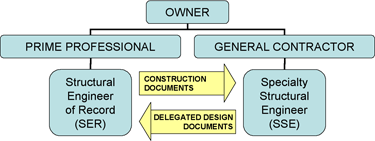
Typical relationship between the SER and SSEs.
It is important that the SER be involved in the project as early as possible, before concepts for architectural, mechanical, and electrical systems have been finalized. The SER can provide valuable input into these decisions, addressing such factors as:
- Type of construction—The selection of the structural system (frame, bearing walls, etc.) depends on the function and dimensions of the building, as limited by the building code and any zoning restrictions, as well as the local availability and relative cost of each material (reinforced concrete, precast concrete, reinforced masonry, structural steel, cold-formed steel, wood, etc.).
- Column locations—A uniform grid facilitates repetitive member sizes, reducing the cost and increasing the speed of construction. Bay dimensions may also be optimized to minimize material quantities while efficiently accommodating specific space requirements, such as parking garages and partition layouts.
- Bracing or shear wall locations—Horizontal forces due to wind, earthquakes, etc. must be transferred down from the superstructure to the foundations. The most efficient means of accomplishing this is usually to provide vertical bracing or shear walls oriented in each principle direction, which must be coordinated with functional and aesthetic requirements for partitions, doors, and windows.
- Floor and roof penetrations—Special framing is often required to accommodate stairs, elevators, mechanical chases, exhaust fans, and other openings.
- Floor-to-floor heights—Adequate space must be provided for not only the structure itself, but also raised floors, suspended ceilings, ductwork, piping, lights, and cable runs for power, communications, computer networks, etc. This may affect the type of floor system (reinforced concrete beams, joists, or flat plates; structural steel beams or open web steel joists; cold-formed steel or wood joists or trusses) that is selected.
- Exterior cladding—The building envelope not only defines the appearance of the facility, but also serves as the barrier between the inside and outside worlds. It must be able to resist wind and other weather effects while permitting people, light, and air to pass through openings such as doors, windows, and louvers.
- Equipment and utility arrangements—Large equipment (air handling units, condensers, chillers, boilers, transformers, switchgear, etc.) and suspended utilities (ductwork, piping, light fixtures, conduits, cable trays, etc.) require adequate support, especially in areas subject to seismic activity that can induce significant horizontal forces.
- Modifications to existing buildings—Changing the type of roof or roofing material, adding new equipment, and removing load-bearing walls are common examples of renovation measures that require structural input.
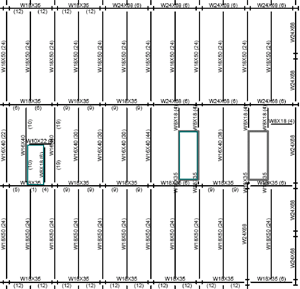
Partial framing plan showing repetitive bay and member sizes and locations for shear walls and framed openings Photo Credit: Burns & McDonnell
Early SER involvement is especially critical for fast-track and design-build projects, when it is often necessary to issue the structural construction documents well in advance of those prepared by other disciplines. Even in conventional design-bid-build situations, the structural system is the first to be constructed, providing the underlying framework for the rest. Close coordination among all members of the design team is essential throughout the design process.
The structural engineer is concerned with providing not only adequate strength for the building, but also serviceability. Beams that deflect excessively under their design loads can cause problems with floor and ceiling finishes, especially those that include brittle materials. A light and inexpensive framing system may exhibit uncomfortable vibrations when subjected to human foot traffic. If high winds cause considerable lateral movement, unacceptable cracks may develop in exterior walls and interior partitions.
The SER should continue to be involved in a building project until construction is complete. No set of documents is perfect; review of submittals and firsthand observations at the site may reveal conflicts between disciplines or misinterpretations by the contractor at a point in time when it is still possible to correct them with minimal cost and schedule impacts.
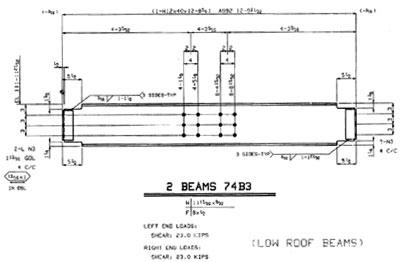
Fabrication shop drawing for a structural steel beam Photo Credit: Burns & McDonnell
Emerging Issues
Structural engineers have a uniquely significant responsibility for protecting the public relative to the other design disciplines. Architectural, mechanical, and electrical system failures usually result in unattractiveness, poor functionality, discomfort and/or inconvenience. A structural system failure almost always has more serious consequences, even in the best cases, there are often substantial costs associated with correcting what is or could become a life-threatening situation. As a result, professional liability insurance rates for structural engineers have been increasing, leading to the creation of the Risk Management Program (RMP). In addition, efforts are underway to establish board certification at the national level and expand separate licensure at the state level to "raise the bar" of qualifications to practice structural engineering.
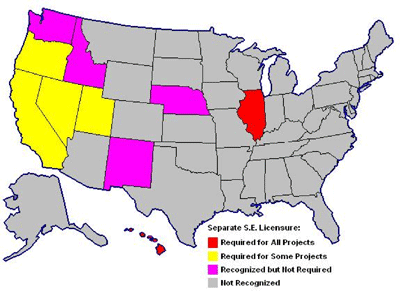
Separate structural engineering licensure in the United States
The events of September 11, 2001 have brought terrorism to the forefront as a design consideration, especially for attractive targets such as "icon" buildings, government facilities, and military installations. Structural engineers who work on these projects, or those nearby that could suffer collateral damage in an attack, must now be familiar with the principles of blast effects analysis and design, as well as resistance to progressive collapse. These phenomena are highly sensitive to nonstructural factors such as standoff distance within the site, facade configurations and connections, and the presence of reentrant corners or transfer girders at the building perimeter. Retrofit of existing buildings to address these considerations is especially difficult and potentially costly.
Relevant Codes and Standards
- American Concrete Institute (ACI)
- American Wood Council (AWC)
- American Institute of Steel Construction (AISC)
- American Iron and Steel Institute (AISI)
- American Society of Civil Engineers (ASCE)
- American Welding Society (AWS)
- Department of Defense (DoD)
- International Code Council (ICC)
- Metal Building Manufacturers Association (MBMA)
- National Fire Protection Association (NFPA)
- Steel Deck Institute (SDI)
- Steel Joist Institute (SJI)
Additional Resources
WBDG
Design Objectives
Historic—Update Building Systems Appropriately, Historic—Accommodate Life Safety and Security Needs, Secure / Safe—Natural Hazards Mitigation, Secure / Safe—Provide Security for Building Occupants and Assets
Project Management
Delivery Teams—Select Appropriate Design Professionals
Professional Associations
- American Concrete Institute (ACI)
- American Institute of Steel Construction (AISC)
- American Iron and Steel Institute (AISI)
- American Society of Civil Engineers (ASCE)
- American Wood Council (AWC)
- Council of American Structural Engineers (CASE)
- National Council of Structural Engineers Associations (NCSEA)
- Structural Engineering Certification Board (SECB)
- Structural Engineering Institute (SEI)
Industry Organizations
- American Forest and Paper Association (AF&PA)
- American Institute of Timber Construction (AITC)
- American Welding Society (AWS)
- APA-The Engineered Wood Association (APA)
- Concrete Reinforcing Steel Institute (CRSI)
- International Code Council (ICC)
- Masonry Institute of America (MIA)
- Metal Building Manufacturers Association (MBMA)
- National Concrete Masonry Association (NCMA)
- National Fire Protection Association (NFPA)
- Precast/Prestressed Concrete Institute (PCI)
- Portland Cement Association (PCA)
- Society for Protective Coatings (SSPC)
- Steel Deck Institute (SDI)
- Steel Joist Institute (SJI)
- Steel Stud Manufacturers Association (SSMA)
- Structural Building Components Association (SBCA)
- The Masonry Society (TMS)
- Tilt-Up Concrete Association (TCA)
- Wire Reinforcement Institute (WRI)
- Wood Truss Council of America (WTCA)
Publications
- ANSI/AISC 360, Specification for Structural Steel Buildings, by American Institute of Steel Construction. 2010.
- AISC 325, Steel Construction Manual, 14th Edition by American Institute of Steel Construction. 2011.
- CASE 962, National Practice Guidelines for the Structural Engineer of Record by Council of American Structural Engineers.
- CASE 962B, National Practice Guidelines for Specialty Structural Engineers by Council of American Structural Engineers.
- CASE 962D, A Guideline Addressing Coordination and Completeness of Structural Construction Documents by Council of American Structural Engineers.
- CRSI Manual of Standard Practice 28th Edition by Concrete Reinforcing Steel Institute. 2009.
- PCI MNL-120, PCI Design Handbook 7th Edition by Precast/Prestressed Concrete Institute. 2010.
Tools
- GSA Sustainable Facilities Tool (SFTool)—SFTool's immersive virtual environment addresses all your sustainability planning, designing and procurement needs.








